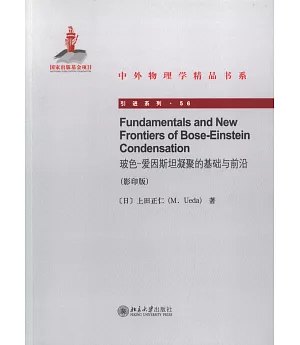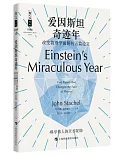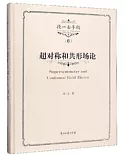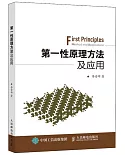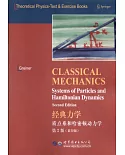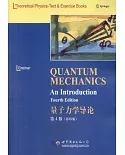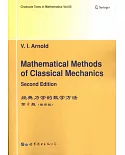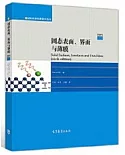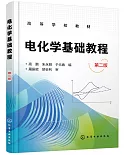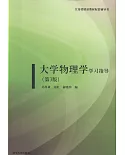內容簡介
首先介紹了玻色-愛因斯坦凝聚(BEC)的基本理論。之后,本書討論了快速旋轉BEC,旋量和偶極BEC,低維BEC等近來發展迅速的方向。本書還介紹了平衡或非平衡費米液體超流,包括BCS-BEC交叉、幺正氣體、p波超流等。本書適合本領域的研究者和研究生閱讀。
目錄
Preface v
1. Fundamentals of Bose-Einstein Condensation
1.1 Indistinguishability of Identical Particles
1.2 Ideal Bose Gas in a Uniform System
1.3 Off-Diagonal Long-Range Order: Bose System
1.4 Off-Diagonal Long-Range Order: Fermi System
1.5 U(1)Gauge Symmetry
1.6 Ground-State Wave Function of a Bose System
1.7 BEC and Superfluidity
1.8 Two-FluidModel
1.9 Fragmented Condensate
1.9.1 Two-statemodel
1.9.2 Degenerate double-well model
1.9.3 Spin-1 antiferromagic BEC
1.10 Interference Between Independent Condensates
1.11 Feshbach Resonance
2. Weakly Interacting Bose Gas
2.1 Interactions Between Neutral Atoms
2.2 Pseudo-PotentialMethod
2.3 Bogoliubov Theory
2.3.1 Bogoliubov transformations
2.3.2 Bogoliubov ground state
2.3.3 Low-lying excitations and condensate fraction
2.3.4 Properties of Bogoliubov ground state
2.4 Bogoliubov Theory of Quasi-One-Dimensional Torus
2.4.1 Case of BEC at rest: stability of BEC
2.4.2 Case of rotating BEC: Landau criterion
2.4.3 Ground state of BEC in rotating torus
2.5 Bogoliubov-deGennes (BdG) Theory
2.6 Method of Binary Collision Expansion
2.6.1 Equation of state
2.6.2 Cluster expansion of partition function
2.6.3 Ideal Bose and Fermi gases
2.6.4 Matsubara formula
3. Trapped Systems 73
3.1 Ideal Bose Gas in a Harmonic Potential
3.1.1 Transition temperature
3.1.2 Condensate fraction
3.1.3 Chemical potential
3.1.4 Specific heat
3.2 BEC in One- and Two-Dimensional Parabolic Potentials
3.2.1 Density of states
3.2.2 Transition temperature
3.2.3 Condensate fraction
3.3 Semiclassical Distribution Function
3.4 Gross-Pitaevskii Equation
3.5 Thomas-Fermi Approximation
3.6 Collective Modes in the Thomas-Fermi Regime
3.6.1 Isotropic harmonic potential
3.6.2 Axisymmetric trap
3.6.3 Scissorsmode
3.7 VariationalMethod
3.7.1 Gaussian variational wave function
3.7.2 Collectivemodes
3.8 Attractive Bose-Einstein Condensate
3.8.1 Collectivemodes
3.8.2 Collapsing dynamics of an attractive condensate
4. Linear Response and Sum Rules
4.1 Linear Response Theory
4.1.1 Linear response of density fluctuations
4.1.2 Retarded response function
4.2 Sum Rules
4.2.1 Longitudinal f-sumrule
4.2.2 Compressibility sum rule
4.2.3 Zero energy gap theorem
4.2.4 Josephson sum rule
4.3 Sum-Rule Approach to CollectiveModes
4.3.1 Excitation operators
4.3.2 Virial theorem
4.3.3 Kohn theorem
4.3.4 Isotropic trap
4.3.5 Axisymmetric trap
5. Statistical Mechanics of Superfluid Systems in a Moving Frame
5.1 Transformation toMoving Frames
5.2 Elementary Excitations of a Superfluid
5.3 Landau Criterion
5.4 Correlation Functions at Thermal Equilibrium
5.5 Normal Fluid Density
5.6 Low-Lying Excitations of a Superfluid
5.7 Examples
5.7.1 Ideal Bose gas
5.7.2 Weakly interacting Bose gas
6. Spinor Bose-Einstein Condensate
6.1 Internal Degrees of Freedom
6.2 General Hamiltonian of Spinor Condensates
6.3 Spin-1 BEC
6.3.1 Mean-field theory of a spin-1 BEC
6.3.2 Many-body states in single-mode approximation
6.3.3 Superflow, spin texture, and Berry phase
6.4 Spin-2 BEC
7. Vortices
7.1 Hydrodynamic Theory of Vortices
7.2 Quantized Vortices
7.3 Interaction Between Vortices
7.4 Vortex Lattice
7.4.1 Dynamics of vortex nucleation
7.4.2 Collective modes of a vortex lattice
7.5 FractionalVortices
7.6 Spin Current
7.7 Fast Rotating BECs
7.7.1 Lowest Landau level approximation
7.7.2 Mean field quantum Hall regime
7.7.3 Many-body wave functions of a fast rotating BEC
8. Fermionic Superfluidity
8.1 Ideal Fermi Gas
8.2 Fermi Liquid Theory
8.3 Cooper Problem
8.3.1 Two-body problem
8.3.2 Many-body problem
8.4 Bardeen-Cooper-Schrieffer (BCS) Theory
8.5 BCS-BEC Crossover at T=0
8.6 Superfluid Transition Temperature
8.7 BCS-BEC Crossover at T≠0
8.8 Gor’’kov-Melik-Barkhudarov Correction
8.9 Unitary Gas
8.10 Imbalanced Fermi Systems
8.11 P-Wave Superfluid
8.11.1 Generalized pairing theory
8.11.2 Spin-triplet p-wave states
9. Low-Dimensional Systems
9.1 Non-interacting Systems
9.2 Hohenberg-Mermin-Wagner Theorem
9.3 Two-Dimensional BEC at Absolute Zero
9.4 Berezinskii-Kosterlitz-Thouless Transition
9.4.1 Universal jump
9.4.2 Quasi long-range order
9.4.3 Renormalization-group analysis
9.5 Quasi One-Dimensional BEC
9.6 Tonks-Girardeau Gas
9.7 Lieb-LinigerModel
10. Dipolar Gases 261
10.1 Dipole-Dipole Interaction
10.1.1 Basic properties
10.1.2 Order of magnitude and length scale
10.1.3 D-wave nature
10.1.4 Tuning the dipole-dipole interaon
10.2 PolarizedDipolar BEC
10.2.1 Nonlocal Gross-Pitaevskii equation
10.2.2 Stability
10.2.3 Thomas-Fermi limit
10.2.4 Quasi two-dimensional systems
10.3 Spinor-Dipolar BEC
10.3.1 Einstein-de Haas effect
10.3.2 Flux closure and ground-state circulation
11. Optical Lattices 277
11.1 Optical Potential
11.1.1 Optical trap
11.1.2 Optical lattice
11.2 Band Structure
11.2.1 Bloch theorem
11.2.2 Brillouin zone
11.2.3 Bloch oscillations
11.2.4 Wannier function
11.3 Bose-Hubbard Model
11.3.1 Bose-Hubbard Hamiltonian
11.3.2 Superfluid-Mott-insulator transition
11.3.3 Phase diagram
11.3.4 Mean-field approximation
11.3.5 Supersolid
12. Topological Excitations
12.1 Homotopy Theory
12.1.1 Homotopic relation
12.1.2 Fundamental group
12.1.3 Higher homotopy groups
12.2 Order Parameter Manifold
12.2.1 Isotropy group
12.2.2 Spin-1 BEC
12.2.3 Spin-2 BEC
12.3 Classification of Defects
12.3.1 Domains
12.3.2 Line defects
12.3.3 Point defects
12.3.4 Skyrmions
12.3.5 Influence of different types of defects
12.3.6 Topological charges
Appendix A Order of Phase Transition, Clausius-Clapeyron Formula, and Gibbs-Duhem Relation
Appendix B Bogoliubov Wave Functions in Coordinate Space
B.1 Ground-State Wave Function
B.2 One-Phonon State
Appendix C Effective Mass, Sound Velocity, and Spin Susceptibility of Fermi Liquid
Appendix D Derivation of Eq. (8.155)
Appendix E f -Sum Rule
Bibliography
Index
1. Fundamentals of Bose-Einstein Condensation
1.1 Indistinguishability of Identical Particles
1.2 Ideal Bose Gas in a Uniform System
1.3 Off-Diagonal Long-Range Order: Bose System
1.4 Off-Diagonal Long-Range Order: Fermi System
1.5 U(1)Gauge Symmetry
1.6 Ground-State Wave Function of a Bose System
1.7 BEC and Superfluidity
1.8 Two-FluidModel
1.9 Fragmented Condensate
1.9.1 Two-statemodel
1.9.2 Degenerate double-well model
1.9.3 Spin-1 antiferromagic BEC
1.10 Interference Between Independent Condensates
1.11 Feshbach Resonance
2. Weakly Interacting Bose Gas
2.1 Interactions Between Neutral Atoms
2.2 Pseudo-PotentialMethod
2.3 Bogoliubov Theory
2.3.1 Bogoliubov transformations
2.3.2 Bogoliubov ground state
2.3.3 Low-lying excitations and condensate fraction
2.3.4 Properties of Bogoliubov ground state
2.4 Bogoliubov Theory of Quasi-One-Dimensional Torus
2.4.1 Case of BEC at rest: stability of BEC
2.4.2 Case of rotating BEC: Landau criterion
2.4.3 Ground state of BEC in rotating torus
2.5 Bogoliubov-deGennes (BdG) Theory
2.6 Method of Binary Collision Expansion
2.6.1 Equation of state
2.6.2 Cluster expansion of partition function
2.6.3 Ideal Bose and Fermi gases
2.6.4 Matsubara formula
3. Trapped Systems 73
3.1 Ideal Bose Gas in a Harmonic Potential
3.1.1 Transition temperature
3.1.2 Condensate fraction
3.1.3 Chemical potential
3.1.4 Specific heat
3.2 BEC in One- and Two-Dimensional Parabolic Potentials
3.2.1 Density of states
3.2.2 Transition temperature
3.2.3 Condensate fraction
3.3 Semiclassical Distribution Function
3.4 Gross-Pitaevskii Equation
3.5 Thomas-Fermi Approximation
3.6 Collective Modes in the Thomas-Fermi Regime
3.6.1 Isotropic harmonic potential
3.6.2 Axisymmetric trap
3.6.3 Scissorsmode
3.7 VariationalMethod
3.7.1 Gaussian variational wave function
3.7.2 Collectivemodes
3.8 Attractive Bose-Einstein Condensate
3.8.1 Collectivemodes
3.8.2 Collapsing dynamics of an attractive condensate
4. Linear Response and Sum Rules
4.1 Linear Response Theory
4.1.1 Linear response of density fluctuations
4.1.2 Retarded response function
4.2 Sum Rules
4.2.1 Longitudinal f-sumrule
4.2.2 Compressibility sum rule
4.2.3 Zero energy gap theorem
4.2.4 Josephson sum rule
4.3 Sum-Rule Approach to CollectiveModes
4.3.1 Excitation operators
4.3.2 Virial theorem
4.3.3 Kohn theorem
4.3.4 Isotropic trap
4.3.5 Axisymmetric trap
5. Statistical Mechanics of Superfluid Systems in a Moving Frame
5.1 Transformation toMoving Frames
5.2 Elementary Excitations of a Superfluid
5.3 Landau Criterion
5.4 Correlation Functions at Thermal Equilibrium
5.5 Normal Fluid Density
5.6 Low-Lying Excitations of a Superfluid
5.7 Examples
5.7.1 Ideal Bose gas
5.7.2 Weakly interacting Bose gas
6. Spinor Bose-Einstein Condensate
6.1 Internal Degrees of Freedom
6.2 General Hamiltonian of Spinor Condensates
6.3 Spin-1 BEC
6.3.1 Mean-field theory of a spin-1 BEC
6.3.2 Many-body states in single-mode approximation
6.3.3 Superflow, spin texture, and Berry phase
6.4 Spin-2 BEC
7. Vortices
7.1 Hydrodynamic Theory of Vortices
7.2 Quantized Vortices
7.3 Interaction Between Vortices
7.4 Vortex Lattice
7.4.1 Dynamics of vortex nucleation
7.4.2 Collective modes of a vortex lattice
7.5 FractionalVortices
7.6 Spin Current
7.7 Fast Rotating BECs
7.7.1 Lowest Landau level approximation
7.7.2 Mean field quantum Hall regime
7.7.3 Many-body wave functions of a fast rotating BEC
8. Fermionic Superfluidity
8.1 Ideal Fermi Gas
8.2 Fermi Liquid Theory
8.3 Cooper Problem
8.3.1 Two-body problem
8.3.2 Many-body problem
8.4 Bardeen-Cooper-Schrieffer (BCS) Theory
8.5 BCS-BEC Crossover at T=0
8.6 Superfluid Transition Temperature
8.7 BCS-BEC Crossover at T≠0
8.8 Gor’’kov-Melik-Barkhudarov Correction
8.9 Unitary Gas
8.10 Imbalanced Fermi Systems
8.11 P-Wave Superfluid
8.11.1 Generalized pairing theory
8.11.2 Spin-triplet p-wave states
9. Low-Dimensional Systems
9.1 Non-interacting Systems
9.2 Hohenberg-Mermin-Wagner Theorem
9.3 Two-Dimensional BEC at Absolute Zero
9.4 Berezinskii-Kosterlitz-Thouless Transition
9.4.1 Universal jump
9.4.2 Quasi long-range order
9.4.3 Renormalization-group analysis
9.5 Quasi One-Dimensional BEC
9.6 Tonks-Girardeau Gas
9.7 Lieb-LinigerModel
10. Dipolar Gases 261
10.1 Dipole-Dipole Interaction
10.1.1 Basic properties
10.1.2 Order of magnitude and length scale
10.1.3 D-wave nature
10.1.4 Tuning the dipole-dipole interaon
10.2 PolarizedDipolar BEC
10.2.1 Nonlocal Gross-Pitaevskii equation
10.2.2 Stability
10.2.3 Thomas-Fermi limit
10.2.4 Quasi two-dimensional systems
10.3 Spinor-Dipolar BEC
10.3.1 Einstein-de Haas effect
10.3.2 Flux closure and ground-state circulation
11. Optical Lattices 277
11.1 Optical Potential
11.1.1 Optical trap
11.1.2 Optical lattice
11.2 Band Structure
11.2.1 Bloch theorem
11.2.2 Brillouin zone
11.2.3 Bloch oscillations
11.2.4 Wannier function
11.3 Bose-Hubbard Model
11.3.1 Bose-Hubbard Hamiltonian
11.3.2 Superfluid-Mott-insulator transition
11.3.3 Phase diagram
11.3.4 Mean-field approximation
11.3.5 Supersolid
12. Topological Excitations
12.1 Homotopy Theory
12.1.1 Homotopic relation
12.1.2 Fundamental group
12.1.3 Higher homotopy groups
12.2 Order Parameter Manifold
12.2.1 Isotropy group
12.2.2 Spin-1 BEC
12.2.3 Spin-2 BEC
12.3 Classification of Defects
12.3.1 Domains
12.3.2 Line defects
12.3.3 Point defects
12.3.4 Skyrmions
12.3.5 Influence of different types of defects
12.3.6 Topological charges
Appendix A Order of Phase Transition, Clausius-Clapeyron Formula, and Gibbs-Duhem Relation
Appendix B Bogoliubov Wave Functions in Coordinate Space
B.1 Ground-State Wave Function
B.2 One-Phonon State
Appendix C Effective Mass, Sound Velocity, and Spin Susceptibility of Fermi Liquid
Appendix D Derivation of Eq. (8.155)
Appendix E f -Sum Rule
Bibliography
Index
網路書店
類別
折扣
價格
-
新書87折$329

